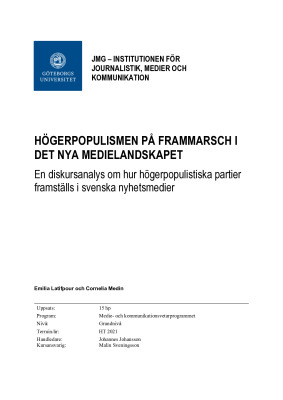HÖGERPOPULISMEN PÅ FRAMMARSCH I DET NYA MEDIELANDSKAPET
En diskursanalys om hur högerpopulistiska partier framställs i svenska nyhetsmedier
Executive summary
Right-wing populism is a political ideology which applies to groups, political parties, and politicians with anti-elitist sentiments which stand in opposition to the establishment. Commonly populists are known for their standpoint against immigration on the basis that
“the people ” and “the elite” are homogeneous and antagonistic groups, thus distancing themselves from the establishment and communicating what the power elite does not dare to express. Right-wing populist movements have been on the rise in recent years and every country in Europe has a populist party represented today. A similar development can be shown in Sweden where The Sweden Democrats have gained increased support in recent decades. Previous research has among other things shown that the news media’s reporting on right-wing populism can be a contributing factor when it comes to normalizing right-wing populist policies. Therefore, this essay is focused on further examining the topic by closer studying how news-media’s reporting on right-wing populist parties in Sweden has developed over time and if it differs depending on media outlet.
This study has shed light upon the role of media in the normalization of right-wing populist politics in Sweden. By researching how the Sweden Democrats are portrayed in two seperate newspapers, the aim of this study is to examine how the portrayal has developed over time
and if it differs between the two media sources. Through a qualitative analysis of the content from two Swedish news media outlets with different ideological positions this essay posed questions regarding how the portrayal of the Sweden Democrats vary depending on media
outlet.
The main questions of the essay were designed to function in a contributing way to one another with the purpose of getting a complete overview of the portrayal and development of
the reporting surrounding the Sweden Democrats within a specific timeframe. Question number one therefore asked how right-wing populist parties are portrayed in Swedish news media, in order to get an overview of how media outlets portray and frame the party in
different ways. Secondly it was asked how the portrayal of right-wing populist parties developed over time in Swedish news media, in order to get a further understanding of how the reporting has changed over time and potentially contributed to a normalization. The third
and final question asks if the portrayal of right-wing populist parties differ between various types of Swedish news media, in order to closely examine how different news outlets may vary in their reporting of right-wing populist parties. Moreover, it is worth pointing out that
there is a potential that the two media outlets may show different developments of normalization. Perhaps change such as normalization has happened in one but not the other outlet, which may be explained by the source’s ideological disposition. Methodically this essay implements the theories of discourse analysis with a framing perspective. The discourse analysis allowed a closer analysis of the linguistic aspects of the articles in order to further examine how this may contribute to a certain frame thus highlighting differences and
similarities between the newspapers portrayal of the Sweden Democrats.
The analysis of this study identified six different generic frames that were used in the newspapers reporting of the Sweden Democrats, however the frames were used at different amounts depending on time, the newspaper and their ideological positions. Moreover, the
analysis of the empirical material could establish that there is a change in how the Sweden Democrats were portrayed during the years 2012, 2016 and 2020. Overall, the newspapers included more frames over time and therefore the reporting became more nuanced. Lastly, the study also discovered a number of differences in the attitude towards the Sweden Democrats where Svenska Dagbladet used a larger number of frames to describe the party, resulting in a more nuanced presentation. In contrast, Aftonbladet generally maintained a more consistently negative line in the presentation of the Sweden Democrats through the use of frames.

